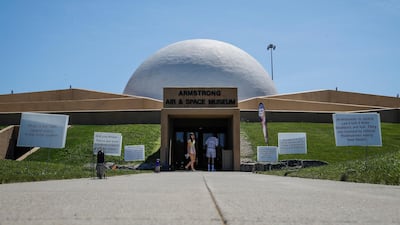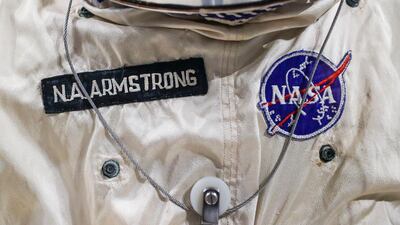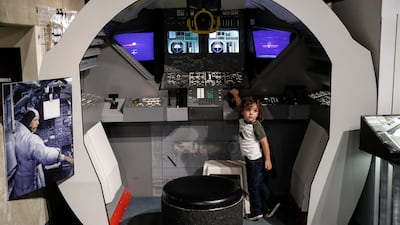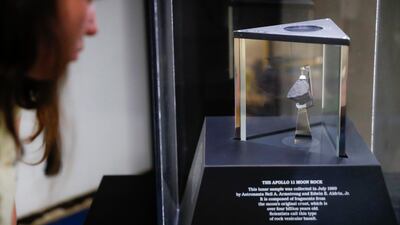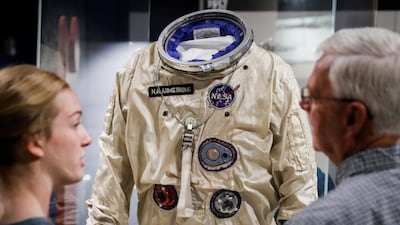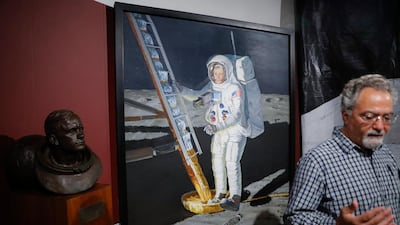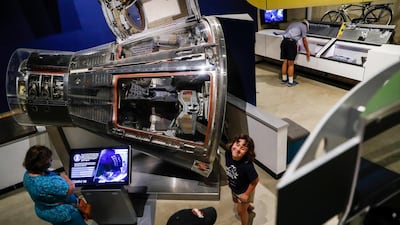At first glance, the picturesque town of Wapakoneta in western Ohio is little more than a slice of small-town Americana. There's a decades-old movie theatre downtown, red, white and blue bunting everywhere you look, and row after row of immaculately maintained homes and manicured front lawns. Except this town is a little special. This month, Wapakoneta is gearing up for its biggest celebration in decades: the 50th anniversary of home town astronaut Neil Armstrong's walk on the Moon.
The Armstrong Air & Space Museum on the edge of town, partially designed to look like a replica lunar base, will host a series of events to mark the day Armstrong became the first man to set foot on the Moon. Nasa TV will broadcast live from the town on Saturday and a team of astronauts will be there to pay homage to a man who went where no one had gone before. About 50,000 people are expected to visit the museum and Wapakoneta during the 10-day celebrations.
Look through the photo gallery above to see more of the Armstrong Air & Space Museum
"He's a superstar, but in a modest way," the museum's executive director, Dante Centuori, says of Armstrong, who died in 2012, aged 82. "There's so much of him woven into the fabric of this community."
Honouring Neil Armstrong
Simply ensuring the museum was built in the first place speaks to the huge regard in which Armstrong is held in the town of 10,000 residents. They raised more than $528,000 (Dh1.9 million) to help fund its construction, with the museum opening in 1972. "Everybody here honours Neil," says Della Rodgers, who works at the Riverside Art Center in the town centre, which is holding an art exhibition dedicated to Wapakoneta's place in space exploration. "He put us on the map. Everyone in the neighbourhood cleaned up their yards; the whole town has been holding fund-raiser after fund-raiser to finance the festivals. The town is coming alive."
The Smithsonian magazine named Wapakoneta as one of the 15 best towns to visit in the US this year, because of its lunar mission commemorations.
As depicted in the 2018 film First Man, Armstrong shunned the public limelight as soon as he landed back on Earth. The man whose steps drew the attention of 230 million people during the first Moon landing in 1969, sought anonymity after the mission was completed. He found that in Ohio.
When he left a teaching role at the University of Cincinnati in 1980, a two-hour drive south of his home town, no one knew why. He then worked as a spokesman for several high-profile companies but spent most of his time alone on his farm in Ohio. When a New York Times reporter went in search of Armstrong's network of contacts across the state on the 25th anniversary of the Moon landing, he encountered a wall of silence – no one would breach Armstrong's trust and speak about their most famous neighbour.
Nasa struggles
But while Armstrong was the face of a new dawn of human exploration, Nasa and its behind-the-scenes scientists and engineers have been its backbone, launching more than 160 manned space missions. Today however, Nasa's star has fallen far; it has an annual budget of about $20 billion – about 0.5 per cent of the US federal budget – while in the 1970s, the US government spent as much as 4.5 per cent of its budget on space exploration, partly due to an expensive space race with the Soviet Union.
These days, private and profit-driven companies such as Elon Musk's SpaceX and Richard Branson's Virgin Galactic have taken up the mantle from Nasa, but not without criticism. For example, Musk's decision to launch a Tesla Roadster electric car into space last year was widely considered to be a marketing ploy, with 2.3 million people across the world watching on YouTube. The launch cost more than $90 million.
Private companies also face difficulties as the market for delivering private communication satellites is dwindling, while acquiring security clearance from the US and other governments for more sensitive missions can be difficult. Nasa also continues to face challenges to carrying out space missions. Its Space Launch System rocket, which is scheduled for its inaugural journey in July next year, will cost more than $1bn to release, which is more than 10 times the cost of SpaceX's Falcon Heavy vehicle.
For this reason, private companies are edging ahead in the race to produce reusable launch vehicles. To get US astronauts to the International Space Centre, about 408 kilometres from the surface of the Earth, now requires them to hitch a ride on another country's rocket.
Why space exploration is still matters
Then there's the PR challenge that accompanies missions to space. For younger generations, the first Moon landing is not something tangible in the way it was for those who witnessed it 50 years ago. "We were sitting in front of the TV, holding our breaths and eating popcorn; we were waiting for the first steps on the moon, for the vessel to land in the ocean after successfully returning from the Moon. I was part of that," says Rodgers, who was 10 years old at the time.
Young people today can’t connect with space travel and exploration in the same way because they haven’t been exposed to that, she says.
Still, experts say there is much to be positive about when it comes to space exploration. "There's no shortage of things to inspire people's imaginations and curiosity with the discoveries made with robotic probes," says Centuori. "With the human exploration, the public might have trouble trying to understand what the goal and the focus is because things change. Advancing in space exploration doesn't necessarily mean sending humans further and further."
Whatever the future of space travel holds, at least one thing is for sure: the small American town of Wapakoneta will always have a special place in the history of humankind, as home of the First Man.
